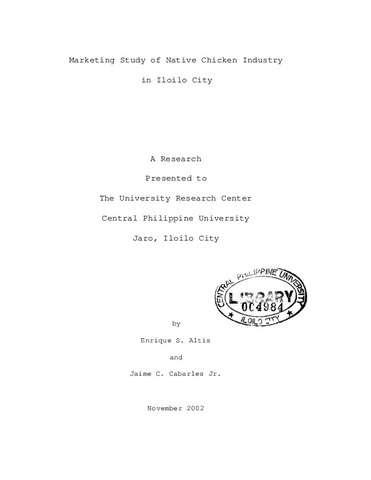Marketing study of native chicken industry in Iloilo City
| dc.contributor.author | Altis, Enrique S. | |
| dc.contributor.author | Cabarles, Jaime C. Jr. | |
| dc.coverage.spatial | Iloilo | en_US |
| dc.date.accessioned | 2021-05-18T05:53:06Z | |
| dc.date.available | 2021-05-18T05:53:06Z | |
| dc.date.issued | 2002-11 | |
| dc.identifier.citation | Altis, E. S. & Cabarles, J. C. , Jr. (2002). Marketing study of native chicken industry in Iloilo City (Research report). Jaro, Iloilo City: University Research Center, Central Philippine University. | en_US |
| dc.identifier.uri | https://hdl.handle.net/20.500.12852/872 | |
| dc.description | Abstract only | en_US |
| dc.description.abstract | The study was conducted from November 2001 to March 2002 in six districts of Iloilo City. This was to determine the recent trends in the procurement and selling of native chicken as an industry and to establish a baseline data, which will serve as the bases for further study to develop the industry. The results of the study showed that the center of native chicken trading is in Rizal St., Iloilo City, in front of the Iloilo Central Market. It was in this place where most of native chicken dealers/buyers and processors meet. Results of the study further showed that large volume of native chicken is traded in this area every Sunday and Friday. As a delicacy, native chicken in Iloilo City were usually roasted, steamed, fried, barbecued or cooked with herb. It is also made into common Filipino delicacies like "binakol", adobong manok, tungkoy with miswa, tinolang manok, arroz caldo and hotpot. Roasted chicken, "binakol" and chicken barbecue were the common delicacies ordered by customers. They enjoyed native chicken dainties because it iii was delicious and juicy compared to fast growing fowl of the same class. The normal daily consumption in Iloilo City was 1,785 heads and it even reached up to 2,690 heads during the months of October to February. A minimal decrease from the normal consumption was observed during the lean months of May to August. Consumption during this period is only 1,626 heads. Pullets and cockerels command a greater demand compared to the mature ones. Health and size were the common criteria followed in pricing native chicken. This was being dictated by the big processors of Iloilo based on the demand of their needs and the availability of supply. Furthermore, the investigation revealed a slight acceptance of upgraded native chicken in the local market. This may be attributed to its meat quality, which is somewhat similar to those of fast growing fowls. Younger upgraded native chickens are also acceptable to the consumers but at lesser price compared to its pure native chicken counterpart. Processors and dealer/buyers predict a continuing increase in demand. Further research should be conducted to increase the production to meet the growing demand. | en_US |
| dc.format.extent | vii, 27 leaves | en_US |
| dc.language.iso | en | en_US |
| dc.publisher | Central Philippine University | en_US |
| dc.subject.ddc | GSL 630.72 Al79 | en_US |
| dc.subject.lcsh | Chickens | en_US |
| dc.subject.lcsh | Chicken industry | en_US |
| dc.subject.lcsh | Marketing | en_US |
| dc.subject.lcsh | Chickens--Marketing | en_US |
| dc.subject.lcsh | Philippines--Iloilo | en_US |
| dc.title | Marketing study of native chicken industry in Iloilo City | en_US |
| dc.type | Technical Report | en_US |
| dcterms.accessRights | Limited public access | en_US |
| dc.description.bibliographicalreferences | Includes bibliographical references | en_US |
| local.subject | Native chicken | en_US |
| local.subject.scientificname | Gallus gallus | en_US |
이 항목의 파일
This item appears in the following Collection(s)
-
Research reports [167]
-
Research reports [37]





